Abstract
Purpose: This article extends earlier studies examining the core competencies of technical communicators. Our project updates these previous perspectives by analyzing the broad range of information products, technologies, professional competencies, and personal traits requested by industry job advertisements. The analysis seeks to answer three main questions:
- What genre/information product knowledge is important for success in the technical communication job market?
- What technology skills are essential for success in the technical communication job market?
- What professional competencies and personal characteristics are essential for success in the technical communication job market?
Method: We analyzed almost 1,000 U.S. technical communication job postings from Monster.com. We mined the postings for position title, job type, education level, experience level, location, salary, and industry sector. We subsequently conducted a content analysis of the job descriptions, using open coding to identify information products, technologies, professional competencies, and personal characteristics.
Results: The job postings exhibited enormous variety in position titles but fell into five main categories: Content Developer/Manager, Grant/Proposal Writer, Medical Writer, Social Media Writer, and Technical Writer/Editor. Information products and technology skills varied substantially with job type. The job postings showed some differentiation in professional competencies across job categories, but they also revealed competencies that were common to all categories.
Conclusion: Technical communication positions now encompass a wide range of audiences, content, contexts, and media. The jobs data illustrate the breadth of products and competencies that drive the field.
Keywords: Job postings, information products and genres, technologies, core competencies, industry snapshot
Practitioner's Takeaway
- Extends previous studies of core competencies and provides empirical support for the continued expansion of technical communication.
- Offers up-to-date understanding of the technical communication jobs landscape and the professional competencies, personal characteristics, information products, and technologies that are most sought after by hiring managers.
- Provides valuable workplace data for those in academia who are engaged with ongoing efforts to keep curricula current and relevant.
Introduction
Technical writers, also called technical communicators, prepare instruction manuals, journal articles, and other supporting documents to communicate complex and technical information more easily. They also develop, gather, and disseminate technical information among customers, designers, and manufacturers. (Bureau of Labor Statistics)
This is the most recent (2014-2015) description of technical communication offered by the Bureau of Labor Statistics in the Occupational Outlook Handbook. Similarly, the Occupational Information Network (O*NET) notes that technical communicators, “Write technical materials, such as equipment manuals, appendices, or operating and maintenance instructions” and “May assist in layout work” (http://www.onetonline.org/link/summary/27-3042.00). What is remarkable about both of these descriptions is that they portray the work of technical communication in terms of more traditional genres and notions of “writing.”
In contrast to these more traditional depictions of the field, practitioners and academics take the position that technical writers are not—and have not been for some time—just writers. The trend toward a greater variety of workplace roles was reported by numerous scholars as early as the 1990s (see, for example, Zimmerman & Long, 1993; Whiteside, 2003), and changes in technologies and composing practices over the past ten years have further broadened the scope of technical communication work (Albers, 2005; Dicks, 2009; Giammona, 2009; Giordano, 2011).
However, the field does not have data that can provide a current snapshot of the technical communication workplace and can identify patterns in job requirements. We know that today's technical communicators need knowledge and skills not only in written communication, but also in information design, multimodal communication, and in a range of tools and technologies (multimodal texts as those that “exceed the alphabetic and may include still and moving images, animations, color, words, music and sound” (Selfe & Takayoshi, 2007, p. 1). But, we don't have up-to-date, empirical evidence to help practitioners and new graduates position themselves effectively within the technical communication market. As Kimball (2015) noted, “What we do, what we call ourselves, how we form and encourage the development of new members of our profession—all have changed so quickly that we must constantly reassess where we stand, what we do, and who we are as technical communicators” (p. 89).
The purpose of this article is to present the findings of an extensive analysis of U.S. industry job postings. We analyzed almost 1,000 job ads collected during a 60-day period from September to November of 2013; we examined the competencies and characteristics that employers are seeking of applicants, as well as patterns in job titles and types, experience and education levels, industry sectors, locations, and salaries. In this article, we argue that the data emphasize not only the breadth of competencies required of today's technical communicators, but also the wide range of career options now available to existing practitioners and new graduates who know how to articulate their qualifications in light of these changes.
We begin with a brief overview of past research that has addressed technical communication competencies. We then discuss our methodology, including how we collected and analyzed the data. We present the study results in four main areas: genre/information product knowledge, tools/technologies, professional competencies, and personal characteristics. Finally, we discuss the implications of the data for practitioners and academic programs.
Past Research
Several studies have looked at workplace expectations and responsibilities in technical communication. These include
- Rainey, Turner & Dayton (2005), who collected data from technical communication managers,
- Lanier (2009), who analyzed job postings for technical writers, and
- Blythe, Lauer, and Curran (2014), who reported on the results of a survey of graduates of professional writing programs.
Collectively, these prior studies present a range of perspectives from managers, job postings, and graduates, and we examine these perspectives in more detail in this section.
Managers' Perceptions
Rainey, Turner and Dayton (2005) surveyed technical communication managers to identify core competencies for technical communicators; the survey was completed by 67 managers from a range of industries and locations. Respondents rated competencies on a Likert scale, according to the perceived importance of those competencies to the day-to-day work of the technical communicator; competencies included capabilities that have traditionally been termed “soft skills,” such as writing and collaboration, as well as “hard skills,” such as facility with various types of technology. The most essential skills overall were the ability to collaborate with subject-matter experts and co-workers and the ability to write clearly for specific audiences and purposes. Also highly ranked were the ability to analyze user needs; utilize word-processing and document-design software; learn to assess and use new technology; and motivate, critique, and evaluate oneself. Managers indicated that the most prevalent information products produced by their technical writers were PDF documentation and hard-copy documentation, followed by online help, style guides, online reference material, Web pages, and training materials.
Overall, the data collected by Rainey, Turner, and Dayton (2005) paint a picture of the field that reflects well-established technical communication processes and products, with the addition of online help and Web pages. Their data provide a valuable baseline for looking at the core skills and competencies of technical communicators; however, the study is over ten years old.
More recent data that reflect the perceptions of managers were reported by Kimball (2015), Baehr (2015), and Dubinsky (2015). As Kimball describes, their collaborative study examined “what technical communication is today, how it works, and who does it, from the perspective of the people who manage technical communication practitioners in successful, highly prominent companies” (p. 89). However, the data resulting from this work reflect the perceptions of only eight managers (fewer at the conclusion of the study) rather than actual job requirements or perceptions of those who are actually technical communicators.
Technical Writing Job Postings
Lanier (2009) contributes a second valuable perspective on the skills required of technical communicators in the workplace. Rather than gathering data from managers, Lanier identified competencies by analyzing job postings collected from Monster.com during a three-month period in 2006. He focused specifically on the knowledge and skills required of technical communicators who were new to the field, restricting his analysis to job postings that required a maximum of two years of technical communication experience. Lanier also excluded jobs that required a specialized technical degree (for example, engineering) and those that included no information about the industry home of the job. Finally, and perhaps most significantly, his analysis examined only job postings for which the job title was “technical writer.”
Lanier ultimately reported on an analysis of 327 job postings. He found that by far the most important competency was communication skills. Employers also tended to expect some level of genre familiarity—knowledge of particular types of information products, such as online help. Lanier reported that subject matter familiarity was called for in many of the job postings. Finally, he noted that technology skills (for example, publishing, graphics, and online help tools) appeared to be more important than indicated by earlier studies.
Like Rainey, Turner, and Dayton (2005), Lanier's study offers valuable insights about core competencies for technical communicators. His methodology is particularly useful for gathering details about employer expectations for new hires. However, the data are now several years out of date, and the field has broadened significantly in that time.
Professional and Technical Writing Graduates
The third valuable perspective that informed our study is that of professional and technical writing graduates who have joined the workforce. Blythe, Lauer, and Curran (2014) reported on the results of a nationwide survey of technical and professional communication alumni regarding the kinds of writing they engaged in, the kinds of writing they valued the most, and the technologies they used. The survey had 257 respondents who had graduated from their respective programs an average of seven years prior to when they took the survey.
The most common information products alumni reported producing were instructions/manuals, Web sites, and presentations, followed by definitions, social media, and grants/proposals (Blythe, Lauer & Curran, 2014, p. 273). Respondents reported that the software tools they most commonly used for this work included word processing, image editing, and desktop publishing software. Also commonly used were social networking, wiki, and blogging tools, and presentation software (pp. 276-277).
Blythe, Lauer, and Curran asked respondents to connect their writing with the genres, locations, collaborators, audiences, and tools they used to complete it. This more holistic perspective complements and builds upon the earlier work done by Rainey, Turner, and Dayton (2005) and Lanier (2009). It also represents the most up-to-date information the field has about the writing work that alumni are doing in and out of the workplace, especially accounting for mobile, Web, and social media writing in ways that previous studies were unable to do. However, Blythe, Lauer, and Curran's research (2014) does not specifically address core competencies for technical communication nor the personal character traits professional and technical writing employers are seeking in their applicants.
Summary
Although the studies reported here offer valuable perspectives on the competencies and genres that form the core of technical communication, they do not provide an up-to-date, large-scale, comprehensive look at the field. Our project seeks to further extend and update these previous perspectives.
Methodology
The goal of our study was to examine the current range of skills, competencies, products, and traits requested of technical communicators in the workplace. We began the study with three main research questions regarding success in the technical communication job market:
- What genre/information product knowledge is important?
- What technology skills are essential?
- What professional competencies and personal characteristics are necessary?
To address these questions, we utilized a method similar to Lanier (2009), in that we collected and analyzed industry job postings over a two-month period. However, because technical communication work has broadened significantly in its scope even in the few years since Lanier's study, we analyzed a much more extensive selection of job advertisements and a much more extensive range of competencies, products, technologies, and traits.
The Genre of the Job Advertisement
Job advertisements, as a genre, have the specific purpose of hiring an employee for a company or organization, so they typically include consistent kinds of descriptive information that can serve as a barometer of industry trends when studied over years and even decades. For instance, Lauer (2013, 2014) studied how specific technology-related keywords were used in twenty years of academic job advertisements. She was able to trace patterns in use that reflected the values and needs of technical communication and writing programs over that time.
As Lanier (2009) discusses, job advertisements are rich sources for analysis because they tend to include a range of detailed information that job seekers might need to determine whether they would like to apply for a job or if they have the right qualifications. In fact, Monster.com recommends that companies developing and posting ads “accurately set job seeker expectations and fully list all related job duties,” because the greater detail a company can include in their ad, the more targeted their applicant pool will be. (“Tips for improving a Job Ad,” http://monster-usen.custhelp.com/app/answers/detail/a_id/4819). This advice encourages companies to craft job ads to be as specific as possible and thus the ads provide researchers with insight into not only job titles and other general information, but also descriptive details about day-to-day responsibilities and expectations.
Job Site Selection
We initially considered collecting job advertisements from multiple sites (Monster.com, Indeed.com, and so forth), to obtain the largest possible data set. However, we ultimately limited the search to one site to reduce the likelihood of collecting duplicate job ads from companies advertising the same job on multiple sites. We utilized Monster.com for the job search because, as Lanier (2009) notes, it is widely used and robust, and, perhaps because of this, it returned more technical communication jobs in our initial searches than any of the other sites we examined.
Because STC hosts a job board, we considered collecting job postings from that site as well. For several reasons, however, we chose not to do so. First, we found that few of the jobs posted on the STC site were actually unique to that site; the majority appeared to be mined from other job sites, which would have led to a potentially high number of duplicate postings. Additionally, because the STC site utilizes a different identification scheme/job ID number than jobs from Monster.com, it would have been difficult to identify and remove duplicates with any level of certainty. Finally, the search capabilities on the STC job board were far more limited than those on Monster.com.
Job Title Selection
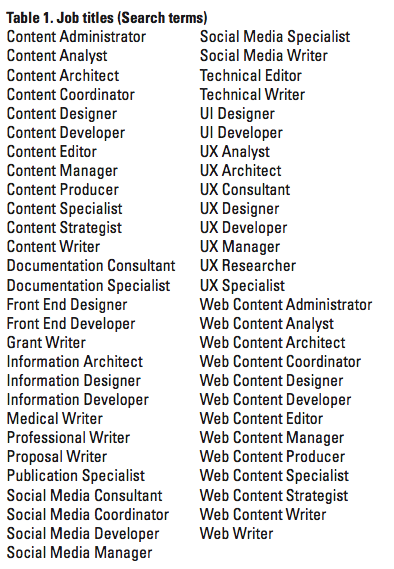
To identify jobs that technical communication graduates and current workers would be qualified to apply for, we began generating a list of possible job titles by looking at the jobs posted on the STC job board. We added to that list by drawing on the job title data provided by the respondents to the survey reported in Blythe, Lauer, and Curran (2014). We then drew upon industry information presented at the STC pre-conference session at the 2013 Council for Programs in Scientific and Technical Communication (CPTSC) conference. Our final list of job titles was extensive, in and of itself supporting the notion that today's technical communicator is far more than a writer in a cubicle (see Table 1).
Data Collection
Utilizing the job titles as search terms, we collected job postings from Monster.com over a 60-day period from September to November of 2013, saving approximately 3,400 job advertisements. An initial examination of the job descriptions, required education, and desired skill set for these advertisements enabled us to cull duplicate postings as well as postings that were not related to technical communication. We also discarded jobs that were focused primarily on technical/tools work rather than rhetorical work, because it is the rhetorical work that is at the heart of technical communication. So, for example, if a posting indicated that the job responsibilities were almost exclusively coding, with little or no design, writing, or client-side communication, then we discarded the job. Additionally, we removed jobs requiring a high level of experience and skills with complex back-end object-oriented programming languages (for example, Java, PHP, C+, Perl), because most graduates of technical communication programs would not have these skills, nor are they at the center of technical communication work. However, we kept jobs that required client-side technical expertise in scripting languages (for example, HTML/CSS/Javascript), since these postings typically suggested that applicants would play a key role in the design of information for an audience.
We kept all jobs that emphasized rhetorically-informed writing, communication, and design skills, even if such jobs requested a familiarity with hard skills that were highly technical. Finally, we kept jobs that fell into a gray area, for which some graduates from technical writing programs may not be qualified, but graduates from certain programs (for instance, Michigan State University's Experience Architecture program), or graduates from a technical writing major with a technical cognate area or minor, could be qualified. Once the culling process was complete, we were left with approximately 1,500 job postings for review.
Our initial examination of the job postings revealed that the jobs fell into two main categories—information development and user experience—with divergent responsibilities, information products, and skill sets. We determined that 914 jobs were information development positions, and it is these jobs on which we focus here. The user experience jobs will be discussed in a separate article.
Data Analysis
We first analyzed the job postings by mining them for position title, job type (full- or part-time, permanent, temporary/contract), required/preferred education level, required/preferred experience level, geographical location, salary, and industry sector. We then began the process of coding for professional competencies and personal characteristics. Competencies, sometimes referred to as “practical skills,” (Henschel & Meloncon, 2014) are more concrete and easily-defined professional abilities, such as editing and project management. Personal characteristics are more abstract traits, such as critical thinking, creativity, and leadership. Henschel and Meloncon (2014) refer to these as “conceptual skills,” and note that these are the “high-order knowledge and literacies a technical communicator needs to be successful and remain flexible in the ever-changing workplace” (p. 5). We prefer the term “personal characteristics” because it emphasizes that these traits can be both innate and learned.
We developed an extensive list of codes for competencies and personal characteristics based on the previous research discussed above. We also utilized the grounded-theory process of open coding (Holton, 2007), whereby we examined the job descriptions for core terms and concepts, and then categorized and labeled those to arrive at the codes. To ensure consistency in coding, we performed a two-phase measure of inter-rater reliability. In phase 1, each of the authors coded a set of ten job descriptions independently of one another; we then calculated the inter-rater reliability using Cohen's Kappa, which measures agreement adjusted for chance. Phase 1 resulted in a Kappa coefficient of k=.79, where .61-.80 is considered substantial agreement. We then discussed the codes on which we diverged, and independently coded a second set of ten descriptions. The Kappa coefficient for Phase 2 was k=.81, where .81-1.0 is considered almost perfect agreement. In both phases, the average percentage of agreement, without adjusting for chance, was 93%. Taken together, these measures indicate very strong inter-rater reliability for the coding process.
Once the codes were in place, we conducted a content analysis of the job descriptions (see Huckin, 2004) to code for information products (that is, the documents and other materials the employee would be expected to produce), tools and technologies, professional competencies, and personal characteristics. Our analysis resulted in an extensive and rich data set that will allow us, throughout the remainder of this article, to report on a wide range of intersecting characteristics and paint a more complete picture of what is expected of job applicants for various positions and experience levels.
Results
We begin our reporting of the study results with the general characteristics of the job advertisements, followed by the information products, tools and technologies, professional competencies, and personal characteristics called for by the postings.
Job Categories, Types, and Locations
The job postings exhibited enormous variety in position titles, substantially exceeding the list provided by Baehr (2015). To enable more meaningful analyses, we grouped the jobs into categories using the position titles, job descriptions, information products, and technology tools. Based on these characteristics, we identified five job categories: technical writer/editor, content developer/manager, social media writer, grant/proposal writer, and medical writer (see Figure 1).
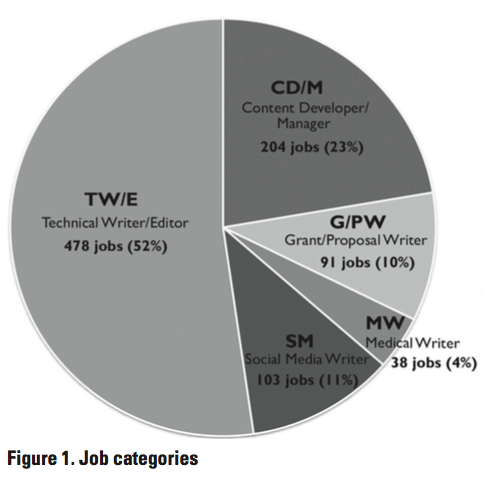
As shown in Figure 1, just over half of the jobs (52%) were in the technical writer/editor category (TW/E); the second largest category was content developer/manager at 22%. Social media writers (SM) comprised 11% of the postings, grant/proposal writers (G/PW) 10%, and medical writers (MW) just 4%.
As Figure 2 illustrates, 69% of the jobs advertised were full-time permanent positions, while 28% were full-time temporary or contract jobs. Very few of the postings (3%) advertised part-time positions. There were proportionately more contract technical writer/editor jobs (41%) than in any other category; in contrast, the social media writer jobs were the least likely to be contract/temporary.
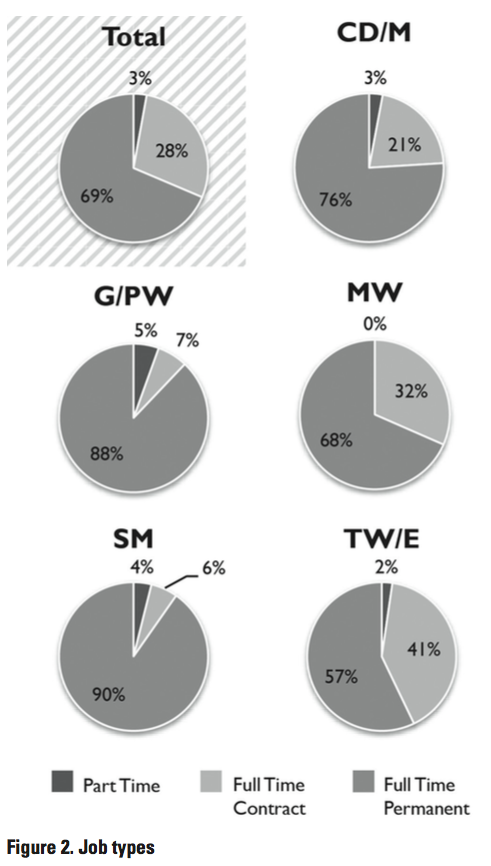
Figure 3 demonstrates the distribution of jobs across a range of industry sectors. For technical writer/editor jobs, the largest concentration (20%) was in the Information Technology Services/Software (IT) sector, followed by Professional/Business Services (13%) and Health/Bio/Pharmaceutical (12%). For content developer/managers, IT still had the largest group of jobs, but the Advertising/Marketing/Public Relations sector was also substantial, at 16%. For medical writers and social media writers, the Advertising/Marketing/Public Relations sector was even more substantial. Not surprisingly, medical writers were most heavily concentrated in the Health/Bio/Pharmaceutical industry (76%). For approximately 10% of the postings, it was impossible to determine the industry with any certainty; these were typically job postings from employment agencies that provided little information about the company.
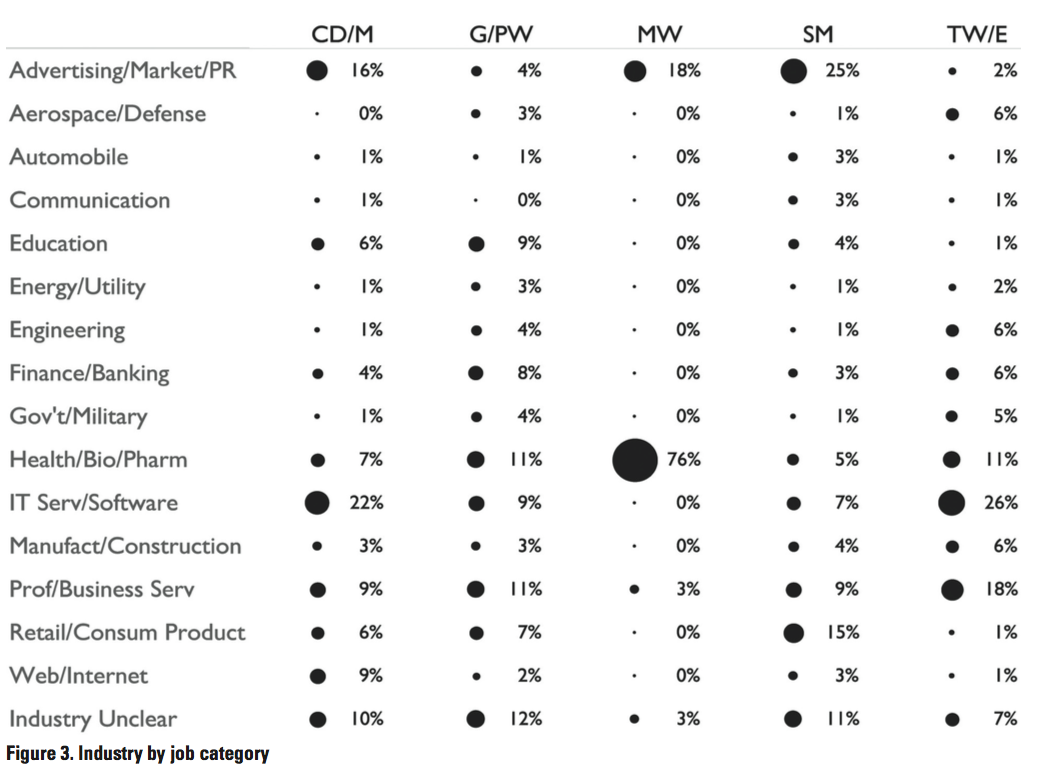
The geographical data we collected align with the data from the 2013-2014 STC Salary Survey. As shown on the map in Figure 4, the jobs overall were concentrated most heavily in the South Atlantic census region (24%), followed by the Pacific (19%) and Mid-Atlantic (18%) regions. The top employers were California and Texas, at 15% and 8%, respectively, which corresponds to the numbers reported by the STC. Virginia ranked third in the STC report. In our study, New York held that position; however, New York had a disproportionately high number of social media jobs, which would not have been included in the STC data. Almost half (47%) of the Medical Writer positions in our study were in the Mid-Atlantic region (see Figure 4).
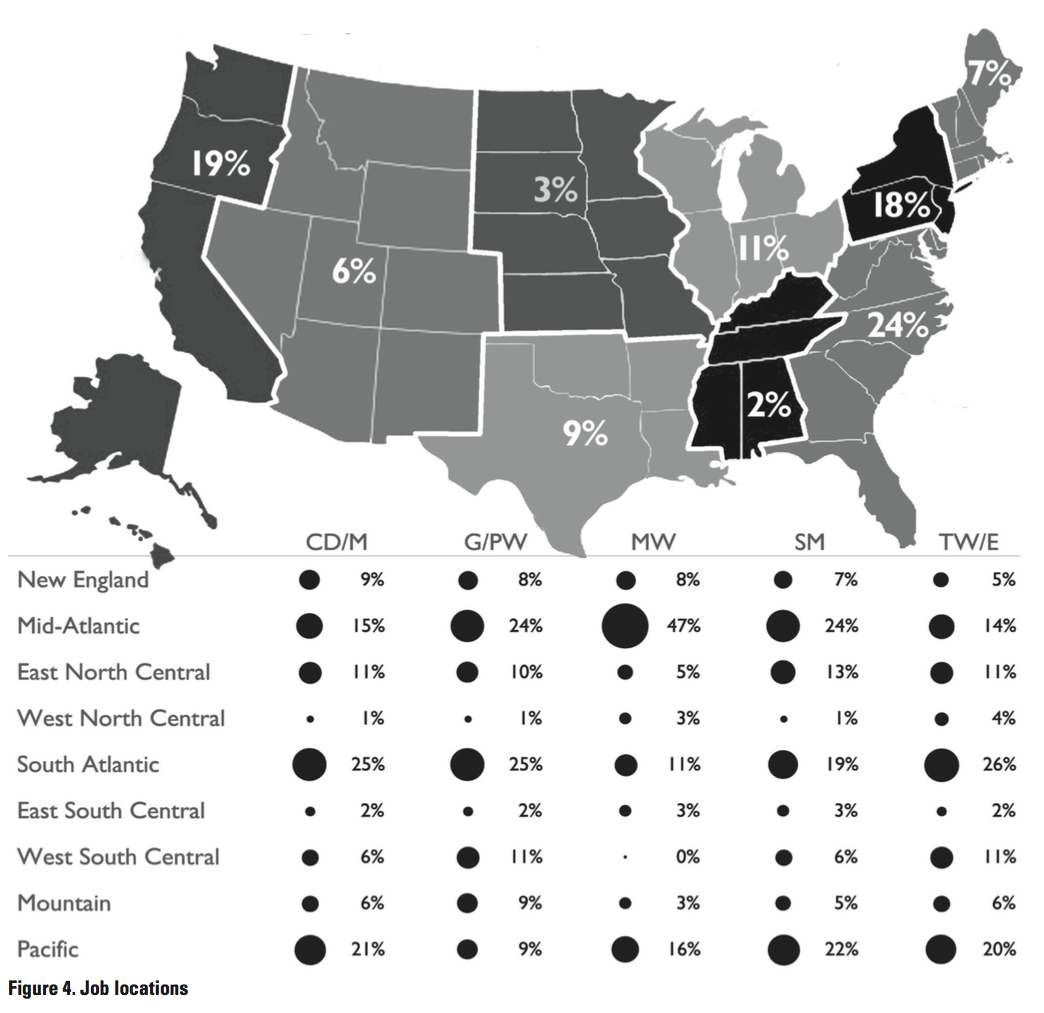
Fewer than 1% of the job postings we collected were for virtual/telecommuting positions, while a handful specified that the positions could be in one of several different locations.
The next section will report further demographic data, including education, experience, and salary. These data typically specify a minimum acceptable level and sometimes a preferred level above that. To present the data consistently, we report the minimum required experience and education levels. Because salary information was typically presented as a range, we averaged all the minimum salary figures together and all the maximum salary figures together and presented the data as a range for both hourly and annual positions.
Education, Experience, and Salary
As shown in Figure 5, the majority of job postings (57%) called for at least a bachelor's degree; however, almost a third of the postings (32%) did not specify a minimum education level at all. Medical writer positions were far more likely to require a graduate degree than any of the other job types (see Figure 5): 26% required a master's, and 5% required a doctorate.
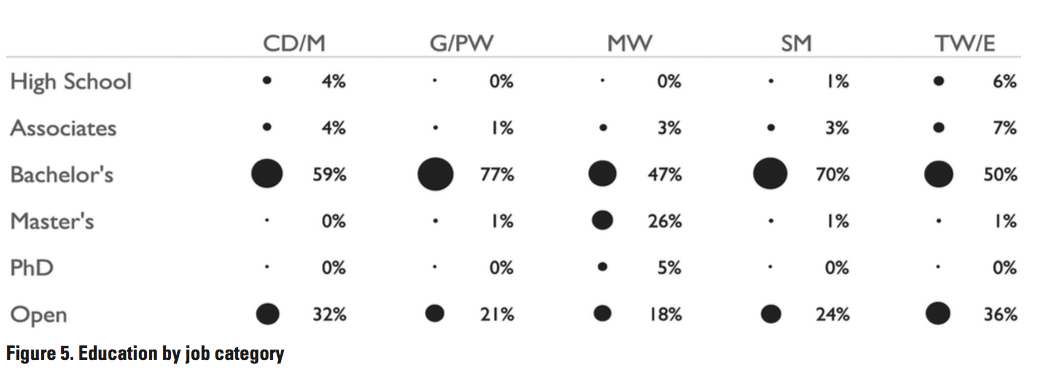
Figure 6 shows the minimum experience levels required across all job types; these ranged from zero all the way up to ten years. Many postings (18%) did not specify an experience level or explicitly stated that it was “open.” Based on the patterns in experience levels, we grouped the jobs into entry level (0-1 year, inclusive, of experience), mid-level (2-4 years of experience), senior level (5+ years of experience), and N/A categories to allow for more meaningful analyses.
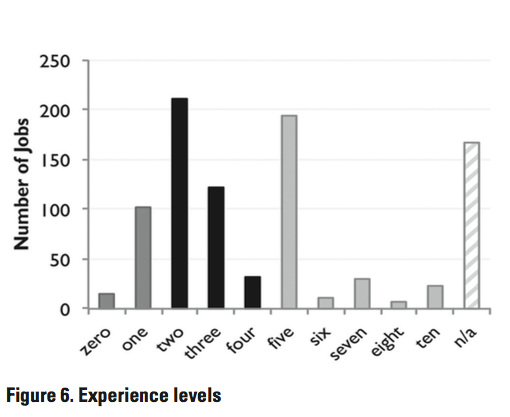
Overall, the largest group of jobs was in the mid-level category. However, there are proportionately more entry-level Content Developer/Manager and Social Media Writer jobs than jobs in any other category.
Not surprisingly, lower education levels were more acceptable in jobs that required fewer years of experience. Among entry-level positions, 10% stipulated a high school diploma as the minimum education, and another 10% called for at least an associate's degree; for the senior-level positions, only 1% indicated that a high school diploma was sufficient, with just 4% accepting an Associate's. However, even among the senior-level positions, few jobs required a graduate degree, although more preferred one.
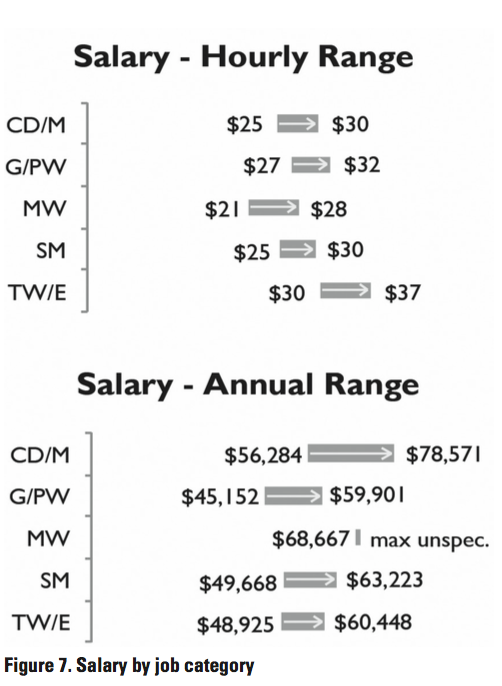
Although Monster.com specifically encourages employers to provide potential applicants with salary and compensation information (“Tips for improving a Job Ad”), only 16% of the job postings provided any sort of salary information beyond stating that pay was commensurate with experience; these were almost evenly divided between hourly and annual jobs. Again, salaries were often provided as ranges, or as minimum values, so we identified ranges for each job category by averaging the minimum values and the maximum values. As shown in Figure 7, hourly rates ranged, on average, from $21/hour to $37/hour; annual salaries averaged from approximately $49K to $78.5K. There was insufficient salary data to calculate a reliable average maximum salary for Medical Writer positions.
Beyond the general demographic information presented above, we engaged in more in-depth analysis of the job ad descriptions to illuminate the breadth of expertise required within the various position categories. We report our findings with regard to information products, tools and technologies, professional competencies, and personal characteristics in the sections that follow.
Information Products
Information products are the genres and content types that applicants will be expected to produce on the job. As Figure 8 shows, the job postings indicated a range of information products for which applicants would be responsible; these serve to differentiate the job categories from one another.
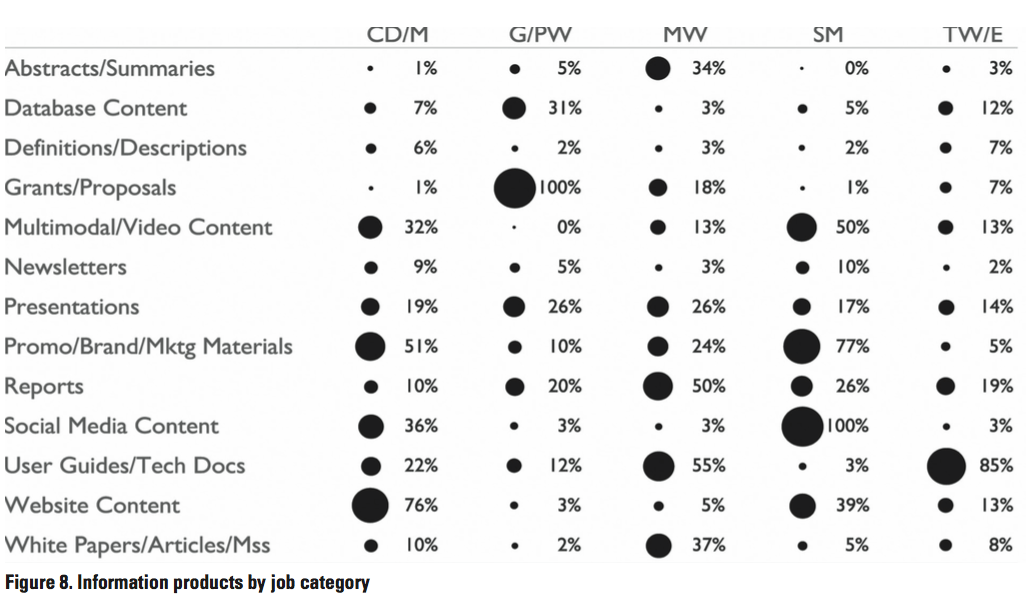
Certain products dominate for some job categories. For example, user guides/technical documents were by far the most visible product for the Technical Writer/Editor category, requested in 85% of those postings (we were unable to consistently determine from the job postings whether these were predominantly intended for print or for digital use). (This finding aligns with the survey results of alumni reported by Blythe, Lauer, and Curran (2014), as well as the managerial perceptions reported by Dubinsky (2015).) Grants/proposals were, unsurprisingly, the dominant product for that job category, although database content was also called for in 31% of the jobs. For the other job categories, the important products are more distributed. For example, while all of the Social Media positions involved social media writing, promotional/brand/marketing materials were extremely important (77%), as was multimodal/video content (50%), and Web site content (39%). For Content Developer/Manager positions, Web site content was the central product (76%), but 51% of the jobs called for promotional/brand/marketing materials, 36% requested social media writing, and 32% asked for multimodal/video content. Likewise, although 55% of the Medical Writer jobs noted that applicants would be producing user guides/technical documents, 50% called for reports, 37% for white papers/articles/manuscripts, and 34% for abstracts/summaries.
Certain information products were important across multiple job categories (see Figure 8). For example, jobs in any of the categories may involve creating presentations, although they were called for in more Grant/Proposal Writer and Medical Writer job postings (26% of each) than in postings from other categories. Similarly, with the exception of Content Developer/Manager positions, reports were an important product across categories, particularly the Medical Writer category. Multimodal and video content were central to Social Media and Content Developer/Manager positions, but much less important in the other categories.
Similar to Lanier (2009), we found that genre knowledge—the ability to craft specific types of information products—is essential in the workplace. However, our data suggest that the PDF documentation—and possibly other hard-copy documentation—that was so highly ranked in Rainey's (2005) data from managers has largely fallen by the wayside to make room for more varied—and more nimble—forms of content. The information products we noted were more consistent with Blythe Lauer, and Curran (2014), which is to be expected, since their study was conducted more recently. Our data also reveal the diversification of information products and the importance of certain products to specific categories of jobs, particularly the emphasis on promotional and branding materials within Content Developer/Manager and Social Media positions.
Tools and Technologies
The job postings reflected an extensive range of tools and technologies, and, as Figure 9 illustrates, these varied with job category. 1
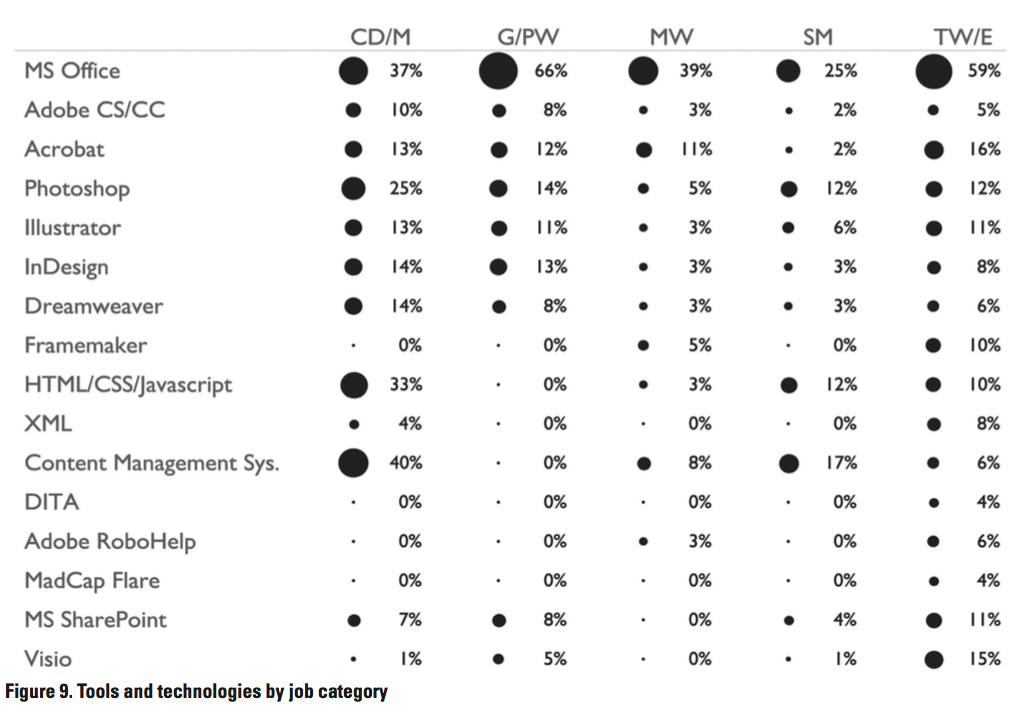
The one exception was MS Office, which was the most commonly requested software in every job category. Medical Writer jobs, beyond their reliance on MS Office, were much less technology-dependent than any of the other jobs. Social Media positions were also not particularly technology-oriented, although 17% of the positions called for skills with Content Management Systems (CMS). For the Grant/Proposal Writer positions, there was some call for skills with design and layout software. Content Developer/Manager jobs had a slightly greater emphasis on these tools, particularly on Adobe Photoshop, but more frequently, those jobs called for skill with HTML/CSS/Javascript/jQuery, and, of course, CMS. Finally, the Technical Writer/Editor positions called for the greatest variety of tools, but with less focus on any one particular tool or type of tool.
While the calls for particular tools typically did not vary with experience level, requests for both MS Sharepoint and MS Visio did increase markedly with experience level, most likely a reflection of increased managerial responsibilities. The dominance of MS Office that we observed is consistent with previous research. However, our data suggest that some facility with additional tools and technologies—particularly CMS, Web scripting technologies, and design and layout software—is also important.
Professional Competencies
We define professional competencies as workplace-related capabilities that are often taught explicitly in technical communication programs, but that are not explicitly tied to a technology and do not necessarily result directly in a product. Content management appears in our data both as a technology (CMS) and as a competency. When a job description focused solely on the use of a content management system, we coded it as a technology. When a posting called for the conceptual and rhetorical work of producing and managing content, we coded it as a competency. A single job could be coded for both if both systems and conceptual work were discussed in the ad.
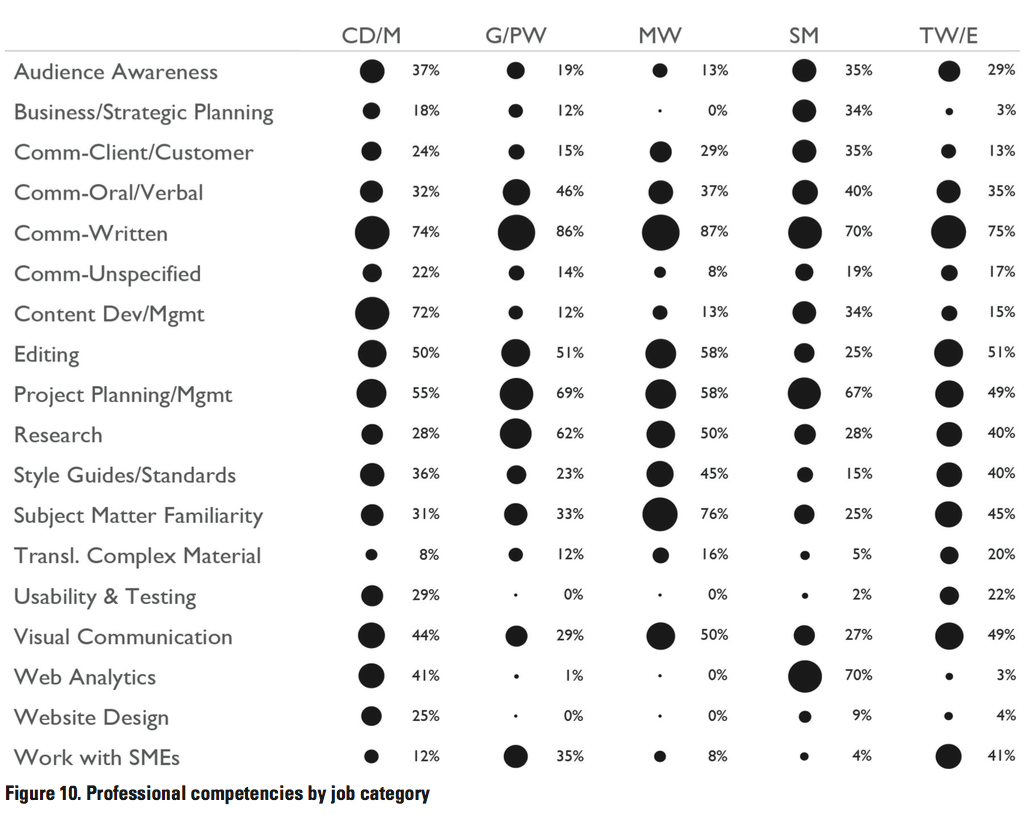
Professional competencies were another differentiating factor among job categories, although, as shown in Figure 10, the differences were more subtle. Almost all of the competencies appeared in every job category, but with different frequency.
Perhaps not surprisingly, written communication was the most frequently requested competency across categories, appearing in at least 70% of the postings in each category, and much more in the Grant/Proposal Writer and Medical Writer categories. Likewise, project management was extremely important in all categories, requested by approximately half the jobs or more in each category. Editing, although called for in only 25% of Social Media positions, was the third most requested competency across all categories. Beyond these competencies, the categories began to diverge more visibly. Visual communication, for example, is central to Content Developer/Manager (44%), Medical Writer (50%), and Technical Writer/Editor (49%) positions, but less so for Grant/Proposal Writer (29%) and Social Media (27%) positions. Similarly, research is vital to Grant/Proposal Writer (62%), Medical Writer (50%), and Technical Writer/Editor (40%) positions, but is much less important for Content Developer/Manager and Social Media jobs (28% each). Subject matter familiarity is enormously important in Medical Writer positions (76%), and important to Technical Writer/Editor positions (45%), but figures less prominently in the other categories.
Not surprisingly, the average number of competencies within a posting increased with experience level; however, we discerned no other clear patterns between competencies and experience level.
Overall, written communication continues to dominate the technical communication landscape, but our data emphasize that several additional professional competencies are also essential, most notably project management, editing, visual communication, research, and, as Lanier (2009) noted, subject matter familiarity. Like our data on information products, the competencies data emphasize the centrality of certain abilities within specific job categories, such as a stronger emphasis on audience awareness and Web analytics in the Content Developer/Manager and Social Media positions, which aligns with their development of promotional/brand/marketing materials.
Personal Characteristics
Personal characteristics are more abstract than professional competencies, including abilities such as analytical/critical thinking, creativity, and so on. As shown in figure 11, overall, personal characteristics show more consistency across job categories than competencies do.
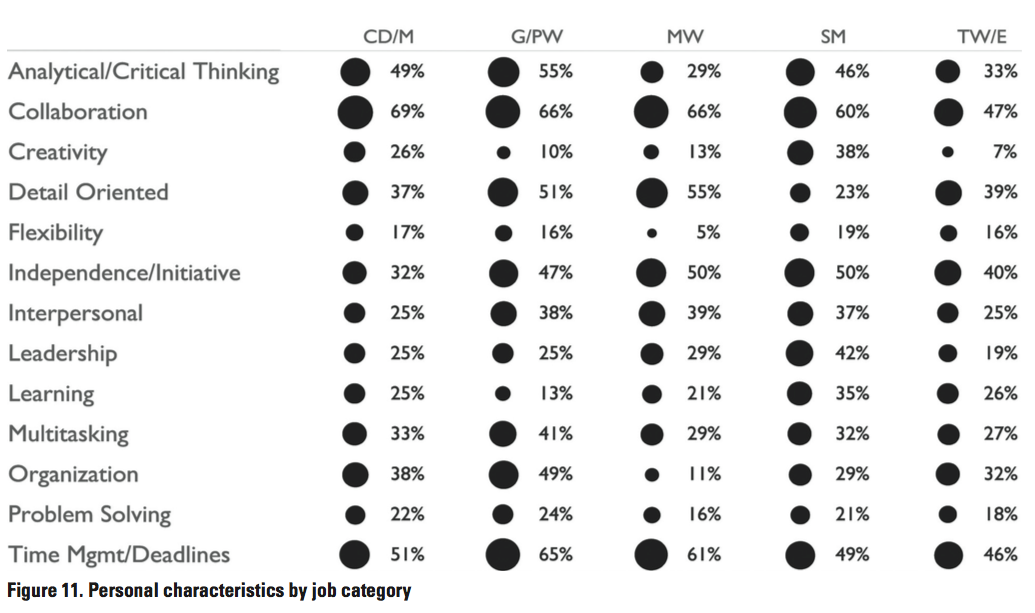
Collaboration and time management were the two most frequently requested personal characteristics across all categories, followed by independence/initiative and analytical/critical thinking. Requests for several of the personal characteristics in particular increased with experience level (see Figure 12).
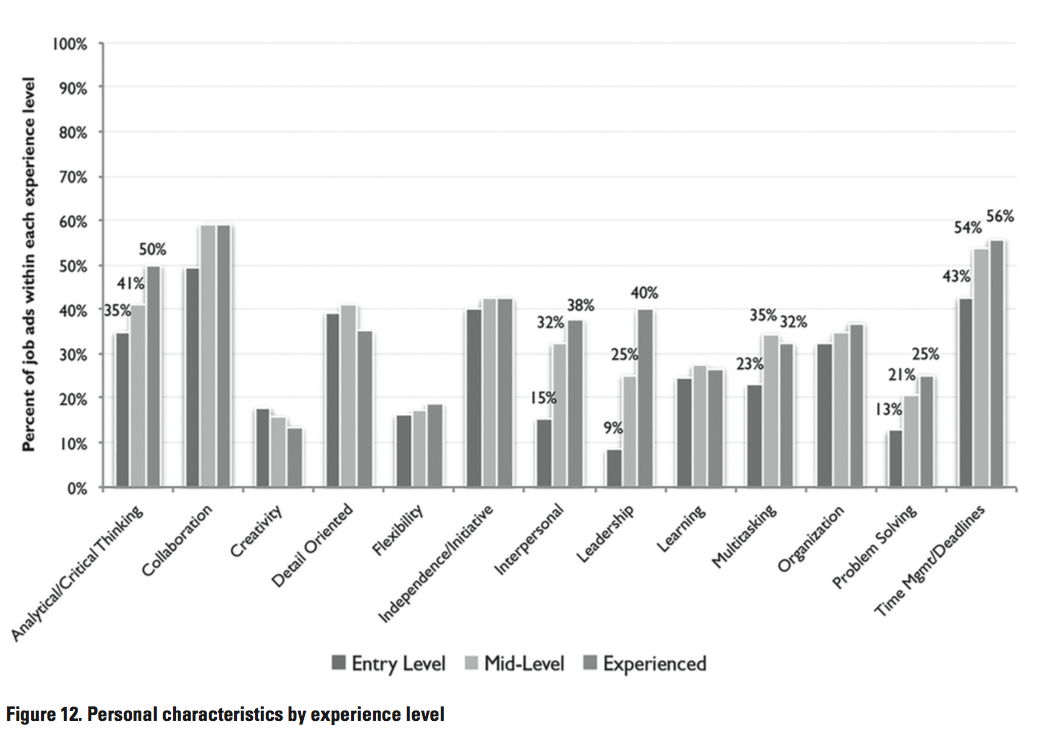
Perhaps to be expected, jobs at higher experience levels were much more likely to call for leadership and interpersonal skills. Requests for analytical/critical thinking and problem solving abilities also increased sharply with experience level, as did requests for time management skills, and to a lesser extent, multi-tasking.
Our data suggest that the personal characteristics required of technical communicators have held relatively constant across studies. Certain abilities continue to be central, although it appears that some new skills—such as multitasking—have entered the mix.
Summary
The data reported here help to modernize our understanding of the field of technical communication. Any one job advertisement cannot speak beyond that single job, but when over 900 advertisements are collected and analyzed for the wide range of characteristics they include, we can see patterns emerge in demographics, products, technologies, and competencies that can inform the knowledge and habits of both programs and practitioners. We will discuss the broader implications of these patterns in the section below.
Discussion
This study shows the breadth of competencies that are now demanded of technical communicators. It also reveals how the positions for which technical communicators are qualified reach beyond instruction and manual writing to encompass a wide range of audiences, content, contexts, and media.
New Positions, New Competencies
Jobs in the more familiar category of Technical Writer/Editor, as well as Grant/Proposal Writer and Medical Writer, comprised two-thirds of the job advertisements we analyzed. However, as Dicks (2009) noted, although technical communication work has remained constant for some in the field, “the nature of work for many technical communicators is changing so rapidly that many now perform an entire task set that they did not even know about five years ago” (p. 51). A full third of the postings we analyzed were for jobs in the newer categories of Content Developer/Manager and Social Media Writer. These jobs were much less (or not at all) visible prior to the wave of mobile and social media development that began in 2007 with the release of the iPhone.
Our data do not entirely support claims that technical communication has undergone a sea change from a document-based model of content development to a topic-based model in which “content is freed from the confines of static documents” (Andersen, 2014, p. 116). The data do, however, support the idea that content—as opposed to documents—drives the newer types of technical communication positions. These positions are also much more likely to require capabilities with Web analytics, Web and social media content, multimodal/video content, and promotional/brand/marketing materials, indicating that employers are beginning to consider content as a tool for building relationships with their customers (Andersen, 2014) and reflecting their brand.
This emphasis on content necessitates a re-examination of academic curricula. Most programs do not require a content management course, nor do they require a course on social media (Meloncon & Henschel, 2013), although these topics may be integrated into other courses. Programs are more likely to require a “Web” course (45%) or to have a “Web” elective (55%), but as Meloncon & Henschel note, such a course is approached many different ways and may not always provide students with a foundation in both the conceptual and applied understanding of Web content authoring, as well as the supporting technology skills they are likely to need in the workplace. For example, Web analytics (including SEO) is a competency that is requested in 70% of Social Media Writer jobs and 41% of Content Developer/Manager jobs, yet it is unclear whether students receive any instruction in Web analytics because analytics are not typically considered “authoring” skills.
Content factors prominently in decisions about information products/genres as well. Programs address a range of information products in their curricula, but promotional/brand/marketing materials are unlikely to receive attention because we have historically considered them to be the purview of marketing and PR programs. Yet, in our analysis of job advertisements, we repeatedly saw employers asking for the ability to represent their brands in a wide range of content—content for which the employee would have full responsibility (including not just marketing and promotional material, but social media interactions as well). An increasing amount of content is being produced in real time, without the luxury of extensive oversight or quality control. Thus, content developers' awareness of how content reflects a brand at all levels is imperative to the material they produce and, in turn, to shaping the overall experience a user has with an organization. This factor strongly suggests that technical communication programs need to help students develop an ever more complex understanding of audience that incorporates awareness of how brand is communicated across content types, styles, and products.
Hybridizations between audience/brand and between technical communication/marketing are already visible in the work of practitioners. For instance, the STC offered a Webinar, based on a progression presented at the 2012 Summit, called “It's All Marcomm: A Tech Writer Goes Fluffy” in which Joe Staples, a technical writer, discusses how his skills have had to expand from producing primarily documentation, guides, and manuals to producing “marcomm” (marketing communications) that includes content like Web and email copy, briefs, white papers, and scripts (Staples, 2012).
In short, our data suggest that there may be substantial curricular work to be done for programs to adequately prepare graduates for new types of technical communication positions.
Shared Competencies
The data demonstrate that several competencies are central to both newer and more traditional types of technical communication positions. These competencies are not new to the field, but some continue to grow in importance. Written communication remains at the top of the list of competencies across all job categories; likewise, editing remains central to technical communication work. Neither is a surprise; at the core, most technical communicators are still writers and editors, even when they are writing and editing new forms of content. Writing and editing are also at the heart of academic programs. However, the data emphasize that technical communicators must also be project planners and visual communicators who have subject matter familiarity.
Project management is crucial to success in today's technical communication workplace. Yet, only 12% of technical communication programs require a project management course, while just 6% offer it as an elective (Meloncon & Henschel, 2013). Of course, some level of project management is addressed informally within other courses, particularly when instructors assign larger projects that involve collaboration and multiple deliverables. However, given the extent to which project management is articulated in job postings, it would be in the best interest of graduates if programs foreground this competency as a curricular objective, teaching it directly and explicitly, whether through dedicated courses or not.
Unlike project management, visual communication now has a central place in technical communication program objectives. Meloncon & Henschel's (2013) data show that the percentage of programs requiring a document/information design course went from 4% to 40% between 2005 and 2011; this aligns with the 43% of job postings that call for visual communication abilities. While programs have made significant strides in incorporating visual communication competencies into curricula, a related product—video—is less commonly taught. A video course is required in only a small fraction (6%) of programs and is offered as an elective in only 12% (Meloncon & Henschel, 2013). It is possible that video analysis and production is incorporated into existing coursework, though this would be more difficult because of the extended time to attend to the complex interaction of modes (still and moving images, sound, text) that video requires. And yet, attention to video/multimodal content is important, because facility with such content is requested in 50% of social media writer jobs and 32% of content developer/manager jobs, and will arguably become more central to technical communication work as video instructions come to complement and, in some instances replace, print and Web-based instructions. Morain and Swarts (2012) argue that “user-generated tutorial videos are quickly emerging as a new form of technical communication” (p. 1), and the complexity of this kind of work is revealed in the six-page rubric they developed for instructors to use to assess instructional videos.
A final important competency merits mention here: subject matter expertise/familiarity, which is substantial across job categories, but even more significant in the MW and TW/E categories, and in jobs at higher experience levels. This is a particularly difficult competency to develop—it cannot be learned through workshops, it cannot be taught within the home departments of technical communication curricula, and it requires a particular mindset: a willingness to learn (called for in many job postings); but more, to learn material that may be outside one's comfort zone. Over half (58%) of academic programs require students to take courses outside the home department (Meloncon & Henschel 2013), but, as Meloncon and Henschel note, we don't have data that tell us what those courses are. Students could be (and many are) completing cognates in English literature when they need to be building their knowledge of engineering, or information technology, or applied biology. Another way for students to develop subject matter familiarity is through internships. The experience levels observed in the jobs data suggest that internships may also be essential in helping students enter a competitive workplace. Again, however, only about half of academic programs require an internship, and those internships vary widely in the degree of technical work involved. Requiring cognates and internships that are well-matched to both student interests and career demands will contribute greatly to graduates' ethos and credibility when they claim they can work with subject matter experts or explain technical material for lay audiences.
Tools and Technologies
Given the range of competencies reflected in the job postings, we expected to see extensive reliance on certain tools and technologies. Although the postings do reflect some level of reliance on multiple technologies, they also illustrate the extent to which MS Office still dominates in relation to other tools. Particularly within the TW/E jobs, we expected greater emphasis on powerful page layout and design tools, since these allow for more sophisticated and complex work in both visual and verbal communication. Adobe Creative Suite/Cloud, or a subset of its component programs, was present to varying degrees across job categories, but less than expected; Adobe's Technical Communication Suite was even less visible. The takeaway here may be that the willingness and ability to learn—again, frequently mentioned in the job postings as a desired characteristic—trumps expertise with a specific toolset. However, applicants who demonstrate both will be the most marketable.
The tools and technologies data raise the perennial question of how technical communication programs can best address the technology requirements of the workplace. Currently, only about one-quarter of technical communication programs require a course whose primary focus is tools, while one-quarter offer a tools elective (Meloncon & Henschel, 2013). More commonly, tools are taught within the context of other courses. In either case, students need to graduate with a conceptual understanding of different types of technologies; skills with a subset of tools that should certainly include MS Office (not only MS Word), and should probably also include Adobe Creative Suite; a deserved sense of self-confidence in their abilities with technologies; and the willingness and initiative to learn new tools independently on the job.
To Specialize or Not
Although the job postings suggest that there remain shared competencies, characteristics, and tools at the core of technical communication, the introduction of new types of jobs, as well as the sheer breadth of information products and professional competencies across job categories, points to a potential dilemma for practitioners and programs: whether to specialize in a particular area within technical communication, or to develop a breadth of knowledge and skills that is even wider than in the past. Baehr (2015) noted that this was a point on which managerial perceptions varied; some participants felt that a broad skillset would “permit technical communicators to be more agile, adaptable, and flexible in their roles and to add greater value to organizations,” while others believed that specialization was “inevitable” (p. 116). Baehr concluded that the best course of action would be to develop multiple specializations, which would “enable technical communicators to define their own roles, to a certain extent” (p. 116). Our data suggest that there are several points of overlap in products and competencies, which could allow some degree of movement among job categories—or multiple specializations—if one maintains a broad skillset and flexible outlook.
For programs, the question of specialization might be addressed through careful advising or, more formally, through the addition of concentrations or tracks that enable students to develop deeper knowledge in a particular aspect of technical communication.
Articulating Qualifications to Employers
Many of the patterns revealed by the job postings should encourage technical communicators to think carefully about the ways they articulate their qualifications to employers. This is crucial for seasoned practitioners and new graduates alike. For instance, one-third of the job postings leave education open; they do not require a college degree. This means that the burden is on applicants to make a compelling case for the value of their degree—emphasizing relevant coursework, assignments, and experiences that a non-degree applicant would not have had access to. And although many jobs prefer graduate degrees, only 2% of all jobs require them, so making the case for what knowledge and experience a graduate degree adds to a technical communicator's resume (especially in areas such as analytical/critical thinking, problem solving, leadership, and research) is especially important for those applicants.
Equally important is applicants' need to confidently and knowledgably negotiate their salary during the hiring process. Because so few jobs indicate a salary range, it may be difficult for applicants to determine where they might fit in a company's salary scale, even with resources like the STC Salary Database. Recent graduates, who are already generally short on confidence and experience, are in a particularly difficult position. Negotiating poorly at the entry level can have exponentially negative consequences on one's salary trajectory. Additionally, women and minorities, who are already well documented as earning less in the workplace, are especially susceptible to accepting a lower salary if they are not aware of the ranges that exist or lack confidence in their ability to negotiate. It is thus vital for applicants to cast a wide net for the most current salary data available.
Finally, faced with new job types, new products, and an ever-growing set of competencies, technical communicators need to consider more carefully than ever before how they will craft applications to best demonstrate the currency and relevancy of their abilities.
Conclusion
The study reported here has important implications for both practitioners and academic programs. One question that cannot be answered by our study is how closely the day-to-day tasks and responsibilities of technical communicators align with those described in the job postings. The postings may have been written by those within a technical communication department or project team—individuals who would work closely with or supervise the applicant and would thus be intimately familiar with the requirements of the job. However, the ads could also have been written by personnel who are not directly involved with the position (headhunters, HR representatives, and so forth). This is a limitation of our data set that we will be addressing in phase two of our study, during which we will be conducting site visits and interviews with employees that represent each of the different job categories we've discussed in this study.
The limitation above notwithstanding, our study provides data that are valuable for both practitioners and academic programs, particularly as we consider the impacts of new types of technical communication work. For practitioners, the study offers a detailed and up-to-date understanding of the technical communication jobs landscape and the professional competencies, personal characteristics, information products, and technologies that are most sought after by hiring managers. Perhaps as importantly, the data offer practitioners ways of thinking about and framing their work to further their careers.
The study also provides valuable workplace data for those in academia who are engaged with ongoing efforts to keep curricula current and relevant, as well as those who work closely with students preparing to graduate and enter the workforce. The data point to potential disconnects between what is required of students in the classroom and what will be expected of them in the workplace. This in turn suggests that programs may want to consider updating or expanding their curricular requirements and core offerings to keep pace with the expansion of technical communicator roles in the workplace. Beyond supporting curricular revision, familiarity with what employers are looking for enables programs to help students craft stronger portfolios and better articulate their qualifications in a competitive market.
References
Albers, M. J. (2005). The future of technical communication: Introduction to special issue. Technical Communication 52, 267–272.
Andersen, R. (2014). Rhetorical work in the age of content management: Implications for the field of technical communication. Journal of Business and Technical Communication, 28(2), 115-157.
Baehr, C. (2015). Complexities in hybridization: Professional identities and relationships in technical communication. Technical Communication, 62(2), 104-117.
Blythe, S., Lauer, C., & Curran, P. (2014). Professional & technical communication in a Web 2.0 world: A report on a nationwide survey. Technical Communication Quarterly, 23, 265-287.
Bureau of Labor Statistics. 2014-2015 Occupational Outlook Handbook. Available at http://www.bls.gov/ooh/media-and-communication/technical-writers.htm
Dicks, S. (2009). The effects of digital literacy on the nature of technical communication work. In R. Spilka (Ed.), Digital literacy for technical communication: 21st century theory and practice (pp. 51–82). New York, NY: Routledge.
Dubinsky, J. (2015). Products and processes: Transition from ‘product documentation to … integrated technical content.' Technical Communication, 62(2), 118-134.
Giammona, B. (2009). The future of technical communication remix. Intercom, 7-11.
Giordano, C. (2011). Integrated technical communications: A strategy for technical communicators. TechWhirl Magazine. Retrieved from http://techwhirl.com/integrated-technical-communications-strategy-for-technical-communicators/
Henschel, S., & Meloncon, L. (2014). Of horsemen and layered literacies: Assessment instruments for aligning technical and professional communication undergraduate curricula with professional expectations. Programmatic Perspectives, 6(1), 3–26.
Holton, J. A. (2007). The coding process and its challenges. In A. Bryant & K. Charmaz (Eds.), The SAGE handbook of grounded theory (pp. 265–289). Thousand Oaks, CA: Sage.
Huckin, T. (2004). Content analysis: What texts talk about. In C. Bazerman (Ed.), What writing does and how it does it: An introduction to analyzing texts and textual practices (pp. 13-32). Mahwah, N.J.: Lawrence Erlbaum Associates.
Kimball, M. (2015). Technical communication: How a few great companies get it done. Technical Communication, 62(2), 89-95.
Lanier, C. (2009). Analysis of the skills called for by technical communication employers in recruitment postings. Technical Communication, 56(1), 51-61.
Lauer, C. (2013). Technology and technical communication through the lens of the MLA Job Information List 1990-2010. Programmatic Perspectives, 5, 211-240.
Lauer, C. (2014). ‘Expertise with multi/modal/new/visual/digital media technologies desired': Tracing composition's evolving concept of textual production through an analysis of the past twenty years of MLA Job Information List advertisements. Computers and Composition, 34, 60-75.
Meloncon, L., & Henschel, S. (2013). Current state of U.S. undergraduate degree programs in technical and professional communication. Technical Communication, 60(1), 45-64.
Monster.com. Tips for improving a job ad. Available at http://monsterusen.custhelp.com/app/answers/detail/a_id/4819
Morain, M., & Swarts, J. (2012). YouTutorial: A framework for assessing instructional online video. Technical Communication Quarterly, 21, 6–24.
Rainey, K., Turner, R., & Dayton, D. (2005). Do curricula correspond to managerial expectations? Core competencies for technical communicators. Technical Communication, 52(3), 323-352.
Selfe, C. L., & Takayoshi, P. (2007). Thinking about multimodality. In Cynthia L. Selfe (Ed.), Multimodal composition: Resources for teachers (pp. 1–12). Cresskill, NJ: Hampton Press.
Staples, J. (2012). It's all marcomm: A tech writer goes fluffy. In Proceedings of the Technical Communication Summit '12. Available at http://summit.stc.org/wp-content/uploads/2012/05/STC-2012-Technical-Communication-Summit-Proceedings.pdf
Whiteside, A. L. (2003). The skills that technical communicators need: An investigation of technical communication graduates, managers, and curricula. Journal of Technical Writing and Communication, 33(4), 303-318.
Zimmerman, D. E., & Long, M. (1993). Exploring the technical communicator's roles: Implications for program design. Technical Communication Quarterly, 2(3), 301-317.
About the Authors
Eva Brumberger is an associate professor and head of the technical communication program at Arizona State University. She has worked in the computer industry as a technical writer and continues to do freelance writing and editing. Her research interests include visual rhetoric and document design, workplace and intercultural communication, and pedagogy. She has published in a variety of journals, has co-edited a collection on teaching visual communication, and serves on the editorial board of the Journal of Visual Literacy and Communication Design Quarterly. She is available at eva.brumberger@asu.edu.
Claire Lauer is an associate professor in the technical communication program at Arizona State University. She teaches courses in visual communication, data visualization, and research methods. Her research has appeared in a range of journals, including Technical Communication Quarterly, Written Communication, Journal of Business and Technical Communication, Kairos, Computers and Composition, and Programmatic Perspectives. She is currently serving as vice chair of ACM's Special Interest Group for the Design of Communication (SIGDOC). She is available at claire.lauer@asu.edu.
Manuscript received: 15 August 2015; revised: 17 September 2015; accepted: 20 September 2015


High school teaches us to “consider our sources.” Thus I’m astounded that the one (one!) source that all this work rests upon was not considered for analysis. Why was Monster.com deemed the most appropriate of job boards for this study? A little bit of research would reveal significant variations in target job seeker backgrounds, employers, and number of users. In fact, there is often little overlap between some major job boards.
Aside from the fact that Indeed.com had supplanted Monster.com as the industry go-to job board some time ago, job boards such as Dice.com and Roadtechs.com are hugely popular within certain segments of industry. Dice.com for instance is comprised of almost exclusively IT postings, with 150+ new tech writer postings today (a Sunday–when the least number of new jobs are posted). And what about the STC national and chapter job boards? Certainly there are significant differences between the tech comm jobs on those boards compared to tech comm jobs on the non-STC boards.
Thus, unless the writers can adequately defend their sampling and source, I seriously question the usefulness of the data presented here.